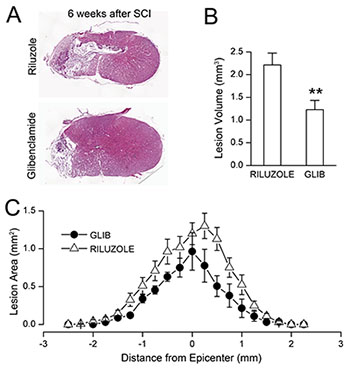


Posted December 17, 2014
Phillip Popovich, Ph.D., Ohio State University, and J. Marc Simard, M.D., Ph.D., University of Maryland, Baltimore
 When the spinal cord is injured by trauma, it is common to have internal bleeding within the spinal cord, in the area of the injury. The amount and extent of bleeding can predict how well an individual will recover from spinal cord injury, where less bleeding is better. Therefore, it is important to understand why some spinal cord injuries cause more or less bleeding and also to develop therapies that can limit bleeding within the spinal cord. Recent studies suggest that glibenclamide (Glib), which has been approved by the U.S. Food and Drug Administration and has been safely used in patients with diabetes, can limit the bleeding in some spinal cord injuries in rodents. Dr. Phillip Popovich from The Ohio State University and Dr. J. Marc Simard from the University of Maryland, Baltimore received a fiscal year 2009 Spinal Cord Injury Research Program Translational Research Partnership Award to identify early markers of injury that can be used to predict which individuals with spinal cord injury may benefit from Glib treatment.
When the spinal cord is injured by trauma, it is common to have internal bleeding within the spinal cord, in the area of the injury. The amount and extent of bleeding can predict how well an individual will recover from spinal cord injury, where less bleeding is better. Therefore, it is important to understand why some spinal cord injuries cause more or less bleeding and also to develop therapies that can limit bleeding within the spinal cord. Recent studies suggest that glibenclamide (Glib), which has been approved by the U.S. Food and Drug Administration and has been safely used in patients with diabetes, can limit the bleeding in some spinal cord injuries in rodents. Dr. Phillip Popovich from The Ohio State University and Dr. J. Marc Simard from the University of Maryland, Baltimore received a fiscal year 2009 Spinal Cord Injury Research Program Translational Research Partnership Award to identify early markers of injury that can be used to predict which individuals with spinal cord injury may benefit from Glib treatment.
To do this, the research team measured the effectiveness of Glib therapy at different levels of injury severity in rats by comparing unilateral vs. bilateral hemorrhage models. Using MRI (magnetic resonance imaging), they found that lesions expanded 2.3-fold during the first 24 hours following injury in control rats, but only 1.2-fold in rats that were treated with Glib. Drs. Popovich and Simard were also able to show that Glib treatment was associated with significantly better function 24 hours after injury in both of the hindlimbs of the injured rats. Importantly, the work done under this award also provided evidence that MRI is an accurate, non-invasive imaging biomarker of lesion expansion and can be used to measure the ability of Glib to reduce the expansion of bleeding in patients with spinal cord injuries.
In other work done by these researchers, they examined the longer-term outcomes of Glib treatment in rats. They found that there was a significant improvement in functional outcome and lesion size after 6 weeks in rats that had been injured and then treated with Glib. The team went on to compare Glib treatment to treatment with Riluzole, a drug that is known to have similar beneficial effects to Glib in rats with spinal cord injuries and is currently being tested in clinical trials (Figure 1). During the timeframe immediately following injury, the two drugs had similar effects. However, 6 weeks after the injury, rats treated with Glib scored better in tests requiring higher level dexterity and coordination and had significantly smaller lesions when compared to rats treated with Riluzole. A third therapy, systemic hypothermia, has also been tested by the researchers and compared to Glib and Riluzole. Their data show that Glib and systemic hypothermia are better than Riluzole in improving outcome measures - including mortality, motor function, balance, and weight gain - in rats subjected to a lower cervical spinal cord injury.
Ongoing work by the team is focused on using MRI to determine if differences in the location of the injury on the spinal cord affect the amount of bleeding at different time points following the injury, and also if specific types of spinal cord injuries may respond better to treatment with Glib than others. Also, based on this and related work, a pilot clinical trial of Glib in human spinal cord injury is being planned by Dr. Francis Farhadi, a neurosurgeon at The Ohio State University School of Medicine.
Additional work needs to be done; however, the early work done by Drs. Popovich and Simard has shown that Glib may be a promising new therapy for patients with spinal cord injuries, and that MRI can be used as an acute biomarker for predicting the efficacy of treatments for SCI.

Figure 1. Comparative effects of Glibenclamide and Riluzole on lesion size. A: Representative H&E-stained sections of spinal cords at the epicenter of injury, 6 weeks after spinal cord injury, from rats treated with either Riluzole or Glibenclamide, as indicated. B,C: Lesion volumes (B) and lesion areas as a function of distance from the epicenter (C), 6 weeks after spinal cord injury, in rats treated with either Riluzole or Glibenclamide (GLIB), as indicated, beginning 3 hours after impact and continuing for 1 week; 13 rats per group.
Publications for Phillip Popovich and J. Marc Simard:
Simard JM, Popovich PG, Tsymbalyuk O, et al. 2013. MRI evidence that glibenclamide reduces acute lesion expansion in a rat model of spinal cord injury. Spinal Cord 51(11):823-827.
Simard JM, Popovich PG, Tsymbalyuk O, et al. 2012. Spinal cord injury with unilateral versus bilateral primary hemorrhage - effects of glibenclamide. Experimental Neurology 233:829-835.
Simard JM, Woo SK, Aarabi B, et al. 2013. The Sur1-Trpm4 channel in spinal cord injury. J Spine S4:002.
Simard JM, Tsymbalyuk O, Keledjian K, et al. 2012. Comparative effects of glibenclamide and riluzole in a rat model of severe cervical spinal cord injury. Experimental Neurology 233:566-574.
Links:














